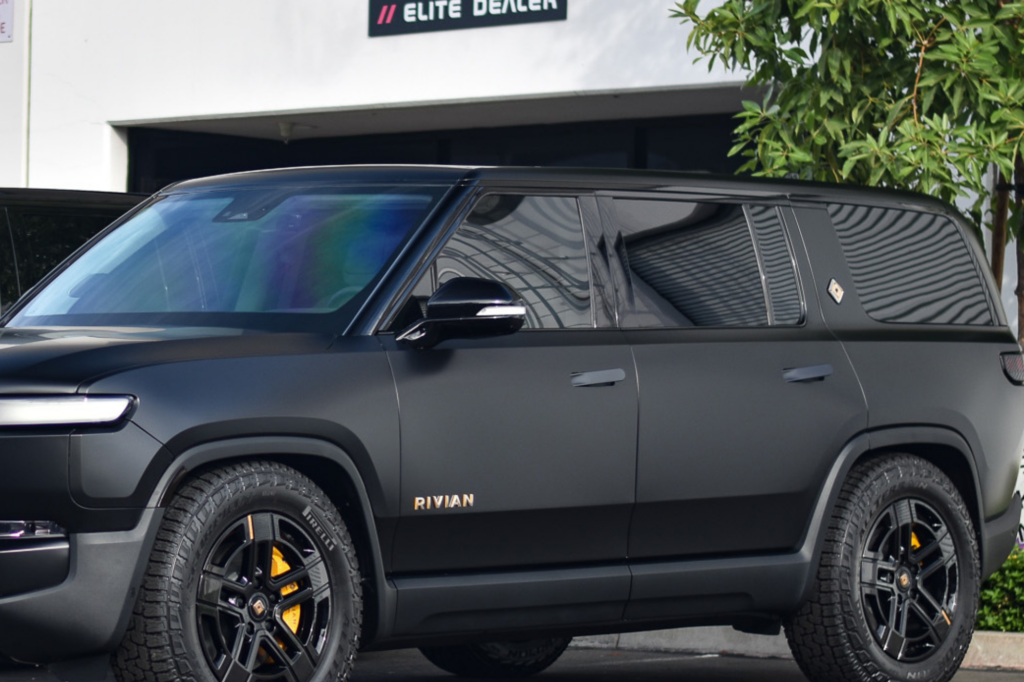Beat the heat effectively by installing heat-blocking window tints in your car. This advanced tint uses multi-layered films packed with heat-reflective and absorbing particles to keep your vehicle much cooler, even during scorching weather. You’ll experience a reduction in interior temps, making less demand on your air conditioning and boosting fuel efficiency. Choose ceramic window tint for top-level heat rejection without compromising visibility or communication signals. This tint also blocks harmful UV rays, protecting your skin and interiors. Safety, efficiency, and comfort are at your fingertips with these products designed for peak performance.
Key Takeaways
- Heat-blocking tint reduces vehicle interior temperatures by 60-70%, keeping your car cooler.
- Multi-layered films reflect and absorb solar radiation, minimizing heat buildup inside the car.
- Ceramic tints provide superior heat rejection without affecting electronic signal clarity.
- Reduced reliance on air conditioning enhances vehicle fuel efficiency.
- Effective UV ray blocking prevents interior fading and protects passengers’ skin.
Understanding Window Tint Technology
When it comes to understanding window tint technology, it’s essential to grasp the fundamental principles that make these films effective. Heat-blocking window tint is specially designed to tackle heat reduction, a primary concern for many vehicle owners. This advanced technology involves applying a thin, multi-layered film to your car’s windows. Each layer plays a vital role in reflecting and absorbing solar radiation, thereby keeping your vehicle cooler.
The materials used are critical for car window tinting for heat reduction. These films often incorporate heat-reflective or heat-absorbing particles, such as metal or ceramic compounds. These components are adept at blocking infrared radiation, which is a major contributor to the heat inside your car.
The precision in the manufacturing process guarantees that the tint performs effectively without compromising visibility or aesthetics. Your choice of tint type greatly impacts its effectiveness. Ceramic films are highly recommended for their superior heat rejection capabilities.
Unlike traditional tints, they don’t interfere with electronic devices, allowing you to stay connected. By opting for heat-blocking window tint, you not only enhance comfort but also increase your car’s efficiency by reducing the reliance on air conditioning.
Benefits of Heat-Blocking Tint
As you explore the role of window tint technology in heat reduction, you’ll appreciate the numerous benefits heat-blocking tint offers.
Its primary strength lies in temperature control, significantly reducing interior heat buildup. This guarantees your car remains cool and comfortable even on the hottest days, sparing you from the discomfort of scorching seats and steering wheels. By minimizing the reliance on air conditioning, this film contributes to improved fuel efficiency, translating into tangible savings over time.
Additionally, the benefits of window tint for keeping the car cool extend beyond mere temperature management. These tints block harmful UV rays, safeguarding your skin and the integrity of your car’s interior. This protection prevents fading, cracking, and deterioration of upholstery and dashboards, thereby maintaining your vehicle’s aesthetic appeal and resale value.
Moreover, heat-blocking tints enhance privacy, deterring prying eyes and offering a sense of security. This aspect is especially beneficial when you’re parked in busy areas.
Fundamentally, investing in high-quality heat-blocking window tint isn’t just about comfort; it’s a strategic choice for long-term savings and vehicle preservation.
Types of Window Tint Available
Exploring the types of window tint available for cars reveals a range of options designed to meet various needs and preferences.
Let’s take a closer look at the details, starting with dyed window tints. These are the most economical choices, offering privacy and reducing glare but with limited heat rejection capabilities.
If you’re seeking something more effective, consider metalized tints. They incorporate tiny metallic particles that reflect heat and UV rays, although they may interfere with electronic signals.
Hybrid tints combine dyed and metalized layers, striking a balance between performance and cost. They provide better heat reduction than dyed tints without the signal interference common in metalized films.
For top-tier performance, ceramic window tints are the go-to option. They use advanced ceramic particles to block a substantial amount of solar heat and UV radiation, ensuring your car stays cool without affecting electronic devices.
Each type of tint offers unique benefits, so consider your priorities—whether it’s budget, heat rejection, or signal clarity.

Installation Process Explained
Installing heat-blocking window tint requires precision and expertise to guarantee peak performance and longevity.
First, you need to clean the windows thoroughly, removing any dirt, dust, or oils that could interfere with the adhesive. Use a lint-free cloth and a mild cleaning solution to make sure no residue is left behind.
Next, measure your windows accurately. Precise measurements are essential, as even a slight error can result in poor fit and reduced effectiveness.
Once measured, cut the tint film carefully, leaving a small margin for trimming after application. Start applying from the top, aligning the film with the window’s edge. Use a squeegee to smooth the film, working from the center outward to remove air bubbles. This step requires patience and a steady hand to avoid creases or bubbles that might compromise the tint’s integrity.
Finally, trim any excess film with a sharp blade for a clean finish. Allow the tint to cure for at least 24 hours before rolling down the windows.
Professional installation is highly recommended, as experts have the tools and experience to guarantee a flawless application, maximizing your tint’s heat-blocking benefits.
Legal Considerations and Regulations
When considering heat-blocking window tint for your vehicle, it’s vital to be aware of the legal considerations and regulations that govern its use. Each region has specific laws regarding the allowable level of tint darkness, often measured by the Visible Light Transmission (VLT) percentage.
For instance, front-side windows typically require a higher VLT to guarantee clear visibility, while rear windows might allow a darker tint. Knowing these regulations before installation can prevent potential fines and the hassle of removing non-compliant tints.
Moreover, some jurisdictions have additional requirements concerning UV protection standards. It’s important to verify that your chosen tint blocks sufficient UV rays without impairing your ability to see clearly, especially at night or in adverse weather conditions. This balance maintains safety while providing the benefits of heat rejection and UV protection.
Additionally, vehicles may have specific exemptions based on medical needs, but these often require documentation and approval.
Before proceeding with installation, verify that your chosen tint complies with local laws by consulting with experienced professionals or checking government resources. For those in the Riverside area, trusted window tint Riverside services can help ensure that your tint meets legal requirements. By adhering to these regulations, you can enjoy a cooler car while driving legally and safely.
Maintaining Your Window Tint
Once you’ve invested in high-quality heat-blocking window tint for your vehicle, maintaining its condition is essential for long-term performance and appearance.
Start by avoiding abrasive cleaning materials that can scratch or damage the film. Instead, use a soft cloth or microfiber towel with a mild, ammonia-free window cleaner. This guarantees the tint remains clear and effective without streaks or residues.
You should also be cautious when handling sharp objects around your windows. Seatbelts, keys, or even jewelry can accidentally nick or tear the tint film, compromising its integrity.
Regularly inspect your tint for any bubbles, peeling, or discoloration. These issues, if caught early, can sometimes be fixed by a professional, saving you from a full replacement.
Avoid rolling down your windows for at least a few days after installation to allow the tint to cure and adhere to the glass fully. This prevents peeling and guarantees a smooth finish.
Finally, be mindful of high heat and direct sunlight, especially in the first weeks, as excessive exposure can affect the tint’s adhesion.
In Summary
By choosing heat-blocking window tint, you’re making a savvy investment in comfort, efficiency, and vehicle longevity. You’ll enjoy a cooler ride, reduced reliance on air conditioning, and protection against UV damage. Remember to select the right type for your needs, guarantee professional installation, and stay informed about legal regulations. For expert installation, consider Vaia Design for high-quality window tinting services. With proper maintenance, your tint will continue to perform at its best. Embrace this smart solution and keep your car cool, protected, and efficient for years to come.

